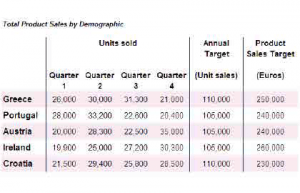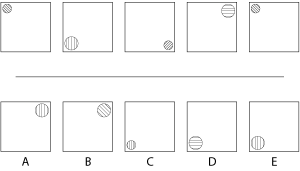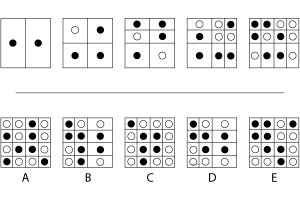Can you ace these Exxon Mobil Job Aptitude Test questions? Start honing your skills with some past questions practice and get a preview of what you can expect on test day.
We pulled these Exxon Mobil Job questions from our study pack Exxon Mobil Jobaptitude-test past questions studypack. Each sample question includes correct answers, so you can see how to crack it!
Sample Exxon Mobil Job Aptitude Test Past Questions and answers
Numerical Reasoning

1. What was the unit sales ratio of Austrian Quarter 4: Portugal Quarter 1: Greek Quarter
4?
(A) 35:28:22
(B) 5:3:4
(C) 6:4:3
(D) 5:4:3
(E) 3:4:2
2. Which country met or exceeded its annual target for unit sales?
(A)Greece
(B)Portugal
(C)Austria
(D)Ireland
(E)Croatia
3. The previous year’s average number of Portuguese units sold per quarter was 20%higher than the year shown. What was the previous year’s average number of Portuguese units sold per quarter?
(A) 104,200
(B) 31,260
(C) 26,050
(D) 21,260
(E) 20,840
4. If Austria’s annual corporation tax was 22% on the first €200,000 of sales and 20% on sales exceeding €200,000, how much is their corporation tax bill for the year (assuming each unit is sold at €3.5)?
(A) €34,000
(B) €34,060
(C) €37,060
(D) €44,000
(E) €78,060
Click here to get the complete Exxon Mobil Job aptitude-test past questions studypack
5. Greek and Irish sales generated 2.5 Euros per unit sold, whilst the other countries’ sales generated 2.25 Euros per unit sold. Which country or countries exceeded their Annual Product Sales Target?
(A)Portugal and Austria
(B)Ireland and Austria
(C)Croatia and Austria
(D)Croatia and Greece
(E)Ireland and Greece
Verbal Reasoning
Passage
The merits of single-sex education have long been debated in the United States, where demand for single-sex schools is on the rise. Title IV, a 1972 law prohibiting sex discrimination in education, was amended in 2006, allowing for the establishment of single-sex state schools so long as a coeducational alternative is available. While critics view single-sex schools as discriminatory and inadequate preparation for adult life, advocates claim that children, and particularly girls, benefit from a single-sex education. American research shows that girls attending single-sex schools have higher self-esteem, participate more in class, and score higher on aptitude tests than their counterparts in co-educational schools. A 2005 study revealed that both girls and boys attending single-sex schools spent more time on homework and had less disciplinary problems. Single-sex schools subvert stereotypical course-taking patterns and results. Advocates of single-sex schooling argue that educators can teach more effectively by tailoring their tuition to reflect current research about gender-based brain development. Many experts, however, believe that research into single sex education is inconclusive, and that so long as the education provided is gender-fair, both girls and boys can thrive in a co-educational environment.
1. Which two of these options must be true?
A. Girls in single sex school perform better in sciences than those in co-educational schools
B. This trend towards America single sex education is a relatively recent phenomenon
C. Research into single-sex is inconclusive
D. Demand for single-sex schools is on the rise
2. Which two of these options must be true?
A. Proponents of single-sex education believe there are different learning styles exist between genders
B. The Usual course taking patterns are avoided in single sex schools
C. The amended law in 2006 allow only the existence of single sex schools
D. Single sex schools provide inadequate preparation for adult life
3. Which two of these options must be true?
A. The only advantage for boys in single sex education is improved discipline
B. Girls in single sex schools have higher self-esteem than their counterparts in co-educational school
C. There are more beliefs than actual conclusions in this passage
D. 1972 law prohibits educational discrimination
4. Which two of these options must be true?
A. Single sex education re-enforces existing gender stereotypes.
B. There are more single-sex schools than co-educational schools.
C. Claims exist for girls benefiting from a single sex education
D. Experts believe that any gender can thrive in a co-educational system
Abstract Reasoning

1. What comes next in the sequence?
(A) A
(B) B
(C) C
(D) D
(E) E

2. What comes next in the sequence?
(A) A
(B) B
(C) C
(D) D
(E) E

3. What comes next in the sequence?
(A) A
(B) B
(C) C
(D) D
(E) E





